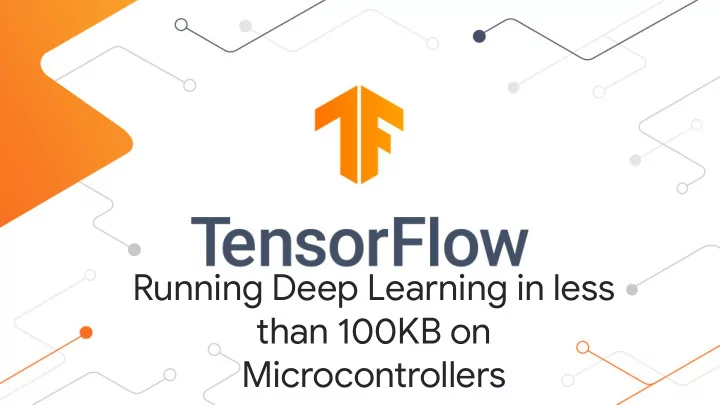

Running Deep Learning in less than 100KB on Microcontrollers
Pete Warden Engineer, TensorFlow petewarden@google.com @petewarden
Why am I here?
150 Billion Devices! Growing faster than internet users or smaruphones
Why ML?
Energy! Many devices rely on batuery or energy harvesting Transmituing data takes a lot of power, and can’t improve fast enough Capturing and processing data locally very cheap
Energy! Most captured data is currently being wasted ML lets us turn it into something actionable
Demo
How is this done?
What are the challenges? Less than 100KB of RAM and storage Less than 10 million arithmetic ops per second Can’t rely on fmoating point hardware No operating system
Model Design We needed a 20KB model Happily common in speech world Learned a lot about quantization Actually just a tiny image CNN on spectrograms
Model Design Uses fewer than 400,000 arithmetic operations htups://www.tensorglow.org/tutorials/sequences/a udio_recognition
Sofuware Design TensorFlow Lite still > 100KB binary size Depends on Posix and standard C/C++ libraries Uses dynamic memory allocation
Sofuware Design But a lot we don’t want to lose from TensorFlow Lite: - Existing op implementations - Well-documented APIs and fjle format - Conversion tooling
Sofuware Design But a lot we don’t want to lose from TensorFlow Lite: - Existing op implementations - Well-documented APIs and fjle format - Conversion tooling
Sofuware Design Modularized existing code Separated out API defjnitions from implementations Used reference code Added minimal new runtime layer for MCUs
Sofuware Design Focused on getuing one end to end example working, rather than going broad poruing whole framework at once
What does this mean in practice?
int32 acc = 0; for (int filter_y = 0; filter_y < filter_height; ++filter_y) { for (int filter_x = 0; filter_x < filter_width; ++filter_x) { const int in_x = in_x_origin + dilation_width_factor * filter_x; const int in_y = in_y_origin + dilation_height_factor * filter_y; // If the location is outside the bounds of the input image, // use zero as a default value. if ((in_x >= 0) && (in_x < input_width) && (in_y >= 0) && (in_y < input_height)) { int32 input_val = input_data[Offset(input_shape, b, in_y, in_x, ic)]; int32 filter_val = filter_data[Offset( filter_shape, 0, filter_y, filter_x, oc)]; acc += (filter_val + filter_offset) * (input_val + input_offset); } } }
Reference code is imporuant Most ML operations can be implemented simply Most frameworks only ship with optimized versions Understandable, but makes it very hard to extend or optimize for other platgorms
What’s the takeaway?
There is no killer app Voice intergaces are the closest Vision, accelerometer, audio sensors ofger a lot Need to connect with the right problems
Think about your domain What could you do if your model ran on a 50 cent chip that could be peeled and stuck anywhere, and run forever?
Get it. Try it. Code : github.com/tensorflow/tensorflow/tree/master/tensorflow/lite/experimental/micro Docs : tensorglow.org/lite/guide/microcontroller Example : g.co/codelabs/sparkfunTF
Pete Warden Engineer, TensorFlow petewarden@google.com @petewarden
Recommend
More recommend